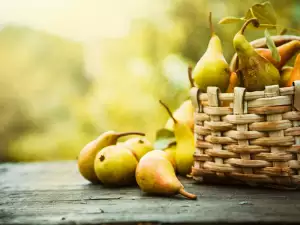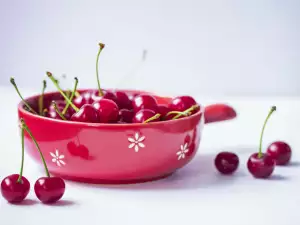Juicy and sweet, with a soft buttery and somewhat grainy texture, the white to cream-colored interior of pears was once called "the gift of the gods." Although the pear season is from the beginning of August to the end of October, different varieties can be found all year round.
Pears, along with apples and quinces, are a member of the Rosaceae family. Depending on their species, their paper-thin skin can be yellow, green, brown, red, or a combination of two or more colors. Like apples they have a core in which several seeds can be found.
Origin of pears
Pears are a delicious fruit, similar to apples and quinces. There are thousands of species that differ in taste, shape, color and storage method. The most common varieties are Anjou, Bartlett, Bosc and Conference.
The scientific name of the pear is Pyrus communis.
When we talk about the origin of the pear, we have to mention two different versions. According to some sources, this fruit was cultivated 3000 years ago in western Asia, while according to others, it dates back to the Stone Age. That aside, the pear has been a hearty fruit of choice throughout the ages.
The interesting thing is that until the 18th century, the pear did not have the taste it has nowadays at all. It was at this time that more attention was paid to its cultivation, and this is how the pear nowadays emerged with its markedly buttery texture and sweet taste.
Nowadays, the main pear growing countries are China, Italy and the USA.

Composition of pears
Pears are a good source of dietary fiber, vitamin C, honey, and vitamin K. Vitamin C stimulates white cells to fight infection by directly killing many bacteria and viruses, and regenerates vitamin E. With the intake of one juicy pear per day, you'll also be taking in 11.1% of the daily value of vitamin C and 9.5% of the daily value of copper.
In 100 g of pears there are 94 g of water, 11.4 g of carbohydrates, 0.1 g of fat, 0.6 g of pectin, 2.3 g of fiber and 0.4 g of protein.
Green pears contain the substance sorbitol, which during the ripening process turns into glucose and pectin. In general, fresh pears are a kind of cocktail of useful substances. They are rich in organic acids (malic, citric, oxalic) and a number of trace elements - magnesium, copper, iron, zinc and phosphorus.
Pears also contain iodine, which is sufficient to satisfy the body's needs for this element. The slightly astringent taste of the fruit is due to the tannins found in its peel. The specific aroma is determined by the essential oils contained in the flesh of the pear.

Use of pears in medicine
Numerous active substances can be extracted from the fruit, which are then used in the production of a number of medicines. For example, pears are rich in arbutin, which has excellent antiseptic properties and this substance is very useful in the treatment of diseases of the kidneys and urinary tract.
A number of studies have been conducted that prove that pears have a very positive effect on the heart as well. The extract of this fruit is quite often used in cosmetology, as it helps to reduce the oiliness of the skin, shrinks the pores and enriches it with vitamins.
Fresh or roasted pears have a mild laxative effect. They also supply the body with the necessary dietary fiber, which in turn leads to the normalization of stools. Modern research proves that regular consumption of pear porridge helps to normalize the functions of the intestines and relieves chronic constipation due to weak peristalsis.

Can we freeze pears?
Yes, pears can be frozen both whole and cut into pieces. It is enough to wash the fruits well, wipe and dry them with a towel, and then freeze them in a form convenient for you. However, we advise you to put them in separate containers or vacuum bags so that they do not absorb the other flavors in your freezer. You can store them for up to a year.
The most important point in this case is defrosting the pears. Ideally, take them out 1-2 hours before consumption and put them on the bottom shelf of your fridge. Thus, the pears will defrost slowly, which in turn will not disturb their shape and structure.
Selection and storage of pears
Since the pear is a rather perishable fruit, it is almost certain that the ones you see in stores will not be fully ripe. They should be left at room temperature until fully ripened. It is at this point - just before they have reached the point of spoilage - that they will have the highest level of antioxidants.
If you want to speed up the ripening process, place them in paper bags or newspapers and turn them periodically. Storing them in plastic bags is undesirable, as they will spoil very quickly. This is only necessary if you want to store them for later a long time in the refrigerator.

Culinary use of pears
- Pears must be washed very well, as it is most beneficial to eat them whole with the peel, due to the fibers found in it.
- If the pear is cut, it will brown quickly. If you want to avoid this process, spray it lightly with lemon or orange juice.
- As part of the desired salad, almost all "greens", leeks and walnuts go well with the pear.
- Serve the pears with goat or blue cheese for dessert.
- Add sliced pears, ginger and honey to your oatmeal.
- Pears are a suitable addition to apple juice or wine.
They can be used both in desserts and as an important ingredient in main dishes, such as foie gras with caramelized pears. Everything here largely depends on your imagination and how far you are willing to experiment in the kitchen. The uniqueness of pears is that with their help you can create real culinary masterpieces with pears, such as:
1. Pear jam;
3. Poached pears;
4. Pear desserts.
Benefits of eating pears
The fiber contained in pears lowers high cholesterol levels, which is extremely good news for people at risk of atherosclerosis and diabetic heart disease. Fiber also binds to cancer-causing chemicals in the colon, protecting its cells from damage. Perhaps this is why diets associated with foods rich in fiber are associated with a reduced risk of colon cancer.
Fiber-rich fruits have been shown to protect against breast cancer in postmenopausal women. Such fruits are apples, plums and pears.
Pears are also considered as a fruit that is not inherent in the development of allergies. When introducing fruit to babies, this fruit is the recommended start.

Research shows that the antioxidant vitamins A, C and E are extremely important for the good functioning of our eyes, which means that a pear added to milk or breakfast cereal will certainly have a beneficial effect.




















Comments